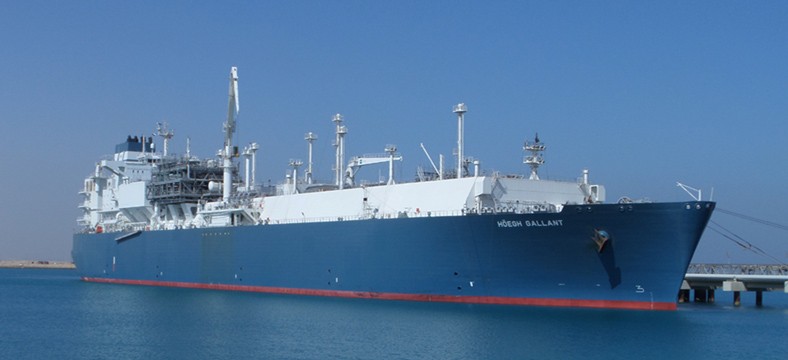Iranian Ship Linked to Houthi Attacks Heads Home Amid Tensions
(Bloomberg) — An Iranian ship that’s been linked to Houthi attacks in the Red Sea is returning home, removing a prominent asset in the area as the Islamic Republic braces...


FSRU Hoegh Gallant. Photo: Hoegh LNG
By Anna Shiryaevskaya
(Bloomberg) — At a time when commodity producers are writing down billions in asset values and canceling projects around the world, one niche area of the gas market is booming.
Hybrid ships, called Floating Storage and Regasification Units, or FSRUs, offer emerging nations from Egypt to Pakistan a cheaper, quicker way to attack power shortages by importing liquefied natural gas. They cost about $300 million to build, or half as much as an onshore import terminal, and are up and running as much as six times faster, sometimes within as little as a year, according to owners Hoegh LNG Holding Ltd. and Excelerate Energy LLC.
As prices for the fuel slumped 64 percent from last year’s peak, the rout made importing the fuel more popular with new buyers seeking a quicker route to LNG amid soaring power demand. Built at shipyards in South Korea, Hoegh sees as many as 55 such vessels in use within 5 years, from about 20 now and just the one a decade ago.
“The main driver is speed,” Sveinung Stohle, Hoegh’s chief executive officer, said by telephone from the company’s Oslo office. “Demand for FSRUs follows a drastic reduction in the cost of LNG. We see that this has caused a very strong increase in requests.”
Hoegh gained 45 percent this year in Oslo trading. By comparison, the 79-member Bloomberg World Mining Index fell 26 percent, led by Glencore Plc’s 55 percent slump as raw materials from coal to copper plunged.
Oil still dominates international energy trade because of the ease in pumping the fuel onto ships. Gas was historically sold just via pipelines, which imposed geographical limits on buying and selling. Now, mirroring oil with the added cost of new infrastructure, LNG will account for most of the 40 percent gain in inter-regional gas trade by 2020, the International Energy Agency forecasts.
FSRUs are emerging as the fastest alternative for imports just as nations imposing limits on carbon dioxide emissions turn to gas, which is twice as clean as coal.
With prices down, “environmentally beneficial natural gas delivered as LNG is becoming competitive with coal” in power generation, said Graham Robjohns, the CEO of Golar LNG Partners LP, in a Aug. 27 earnings call. Hamilton, Bermuda-based Golar LNG has 6 operating FSRUs and two on order. Floating terminals account for 28 percent of the import capacity under construction, according to Bank of America Corp.
Competition to supply FSRUs has cut costs of leasing such vessels by 20 percent to about $120,000 per day from five years ago, said Keith Bainbridge, managing director of industry consultant CS LNG in London.
Copying Oil
Once the 300-meter (1,000-foot) vessels are moored, fuel is transferred from arriving tankers through pipes. The LNG, chilled to minus 162 degrees Celsius (minus 260 Fahrenheit), is then converted onboard into gas and typically used onshore at a nearby power plant. The idea was copied from the oil markets, where floating production, storage and offloading vessels have been used since 1970s, according to the IEA.
LNG will probably trade at $6 to $8 per million British thermal units through 2020 amid slowing demand in core markets such as Japan, South Korea and China, Citigroup Inc. said in July. That compares with $7.10 as of Sept. 14, according to the World Gas Intelligence publication. Prices jumped 72 percent in 2011 as Japan shut its reactors after the Fukushima nuclear disaster. They peaked at $19.70 in February 2014.
The average cost to build the floating terminals will probably more than double in 2017 from $96 per metric ton last year as buyers choose ever-larger vessels, according to the International Gas Union, a lobby group of energy companies in 91 countries. That compares with $212 per ton for a new onshore LNG terminal last year, such as Poland’s. Onshore costs will probably peak at $350 a ton in 2016 amid demand for bigger tanks, according to the group.
Global gas demand will rise 2 percent annually in the six years through 2020, the IEA said in June. Jordan received its first FSRU in May and Pakistan began imports in March. More FSRUs may be needed in Latin America, according to Stohle.
Egypt was a gas exporter until last year. Now, the country is battling power shortages and encouraging domestic gas exploration to meet demand in the future. Imports began in April through the Hoegh Gallant, moored in the Red Sea port of Ain Sokhna. The vessel, which has a capacity of 500 million cubic feet a day, imports enough gas to meet 10 percent of the nation’s annual demand.
Egypt now receives four to five cargoes a month from companies including Vitol Group and Algeria’s Sonatrach. It will receive a second floating terminal by the end of September and plans to lease a third unit next year.
“I wouldn’t be surprised if they add two or three more,” Stohle said. “They have a huge deficit.”
–With assistance from Maher Chmaytelli in Paris and Alaric Nightingale in London.
©2015 Bloomberg News
Join the gCaptain Club for curated content, insider opinions, and vibrant community discussions.


Join the 105,983 members that receive our newsletter.
Have a news tip? Let us know.
Access exclusive insights, engage in vibrant discussions, and gain perspectives from our CEO.
Sign Up




Maritime and offshore news trusted by our 105,983 members delivered daily straight to your inbox.



Essential news coupled with the finest maritime content sourced from across the globe.
Sign Up